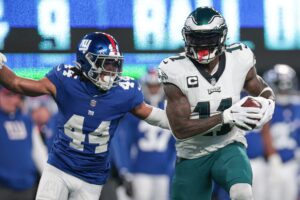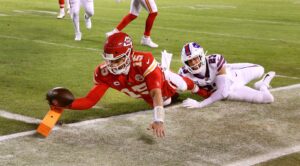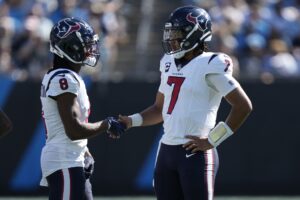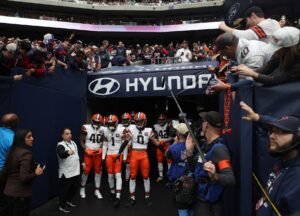The AFC West is going to be one of the best divisions in football in 2020. The division boasts the reigning Super Bowl Champions which speaks for itself. The AFC West also has three other teams that should be able to compete at a high level. The teams in the division will beat up on each other because of how competitive it is. Look for there to be two or even three teams in the playoffs. Below are the AFC West 2020 NFL Draft grades.
Divisional Draft Grades: AFC East – AFC North – AFC South – NFC East – NFC North – NFC South – NFC West
AFC West 2020 NFL Draft Grades
Denver Broncos
Overall Grade: A
Draft Additions: Jerry Jeudy, K.J. Hamler, Michael Ojemudia, Lloyd Cushenberry, McTelvin Agim, Albert Okwuegbunam, Justin Strnad, Netane Muti, Tyrie Cleveland, Derrek Tuszka
During the 2019 season, the Denver Broncos had struggles on both sides of the ball but finished the season on a good note. After starting the season 3-8, they went 4-1 in their last five games to end up with 7-9 record. Finishing the season well is always a good sign for a struggling team and shows resilience going into the following year. But Denver still had a lot of needs to fill going into free agency and the draft.
The Broncos were able to pick up quite a few playmakers and key cogs to help both the defense and their young quarterback Drew Lock. With their first two picks, Denver went with Jerry Jeudy out of Alabama and K.J. Hamler from Penn State. Jeudy was arguably the best receiver on the board, just edging out CeeDee Lamb and Henry Ruggs III. The Broncos drafted a stud who is a great route runner with breakaway speed. He is not a huge guy at 6’1”, but his other skills make him stand out.
Adding K.J. Hamler to the mix is also a plus for Drew Lock. Hamler is a speedy slot receiver who is a matchup nightmare when used correctly. Denver needed help all over the field, so these top two picks were essentially taking the two best available that fit a need.
They also received help on the interior offensive line by drafting Lloyd Cushenberry at the center position. Last season Denver had a hard time running up the middle and relied a lot on stretch runs and rollouts to avoid broken plays. They also struggled with protecting the quarterback at times. Cushenberry can potentially shore up that offensive line.
Tight end Albert Okwuegbunam was not supposed to fall as far as he did and was one of the steals of the draft. He is a big target who has great speed for his size. Okwuegbunam ran a 4.49 40-yard dash at the combine which is in the same ballpark as guys like Jerry Jeudy, who ran a 4.45. He is not the best run blocker but will be a true weapon on third down and in redzone situations. They rounded out their offense heavy draft with solid picks of Fresno State guard Netane Muti and wide receiver Tyrie Cleveland from Florida. Both fill a need for depth and competition in training camp.
The defensive side of the ball only saw four new additions and two of the four are projects that may or may not work out. They picked up a great player in defensive back Michael Ojemudia out of Iowa. He has great size at 6’1” and 200 pounds and length, with long arms to pair with his big body. This goes with the recent trend of getting taller, more athletic defensive backs to compete with bigger receivers and tight ends. Ojemudia is not extremely physical, but can potentially utilize his size and length to succeed in press coverage situations.
Denver also picked up defensive tackle McTelvin Agim from Arkansas. McTelvin is more of a project having only spent one season in his career at the position. Becoming stronger is vital compete with larger NFL offensive linemen. If he does that it could turn him into an everyday starter. The other tw opicks of Wake Forest’s linebacker Justin Strnad and edge rusher Derrek Tuszka from North Dakota State are positional needs and can provide defensive depth.
Los Angeles Chargers
Overall Grade: A-
Draft Additions: Justin Herbert, Kenneth Murray, Joshua Kelley, Joe Reed, Alohi Gilman, K.J. Hill
In 2019 the Los Angeles Chargers had one of the best rosters in the league, at least on paper. But they caught a bad case of the injury bug in both of the previous two seasons. If the Chargers can keep even half of the players healthy that were hurt last year, they will be in good shape. Obviously, the loss of their long time quarterback Philip Rivers will be an adjustment, but they still have so many pieces in place on both sides of the ball that they will have the opportunity to compete at a high level.
They started off the draft by replacing Rivers and getting their potential new franchise quarterback, Justin Herbert out of Oregon. Herbert was and continues to be pegged as one of the top five quarterbacks from this year’s draft. At certain points of last year’s season he was even considered to be the top guy. He is a pro ready quarterback with great size at 6’6”, 236 pounds. Some of Herbert’s strengths are his ability to see the field, read defenses, and stay in the pocket in the face of the rush. The Oregon product is stepping into a position where he has weapons galore with Keenan Allen, Austin Ekeler, and Hunter Henry. Most rookie quarterbacks with his type of talent do not normally inherit such a ready made offense.
Los Angeles also added depth to the running back and wide receiver rooms with fourth-round selection, running back Joshua Kelley (UCLA) and fifth-round draft pick, wide receiver Joe Reed. Kelley is there to bring more bodies into an oft injured running back room and to try and replace Melvin Gordon and be the change of pace back with Ekeler. Joe Reed is a fit with his reliable hands and ability to play on special teams as a kick returner. The Chargers also added wide receiver K.J. Hill (Ohio State). Hill is the all-time leader in catches at Ohio State, but dropped to the seventh round after being projected much higher. This may be a steal for the Chargers and they can now pair him with Keenan Allen and newly added rookie Joe Reed.
The defensive side of the ball for the Chargers got a jolt by adding Oklahoma inside linebacker Kenneth Murray. Murray can run and cover with any tight end in the league and has true sideline to sideline speed. He is also a tackling machine and adding him to an already very dangerous Los Angeles defense has the potential to be scary. Los Angeles also drafted safety Alohi Gilman from Notre Dame. This seems like a “best available” type of pick because they already have depth at the defensive back position. Gilman’s shortcomings show themselves when he is forced into pursuit and zone defensive situations. As stated before though, the Chargers defense is stacked and will benefit from having extra bodies in depth.
Look for the Chargers to be a team that competes for the division, even with a rookie quarterback, as long as they can stay healthy.
Kansas City Chiefs
Overall Grade: B+
Draft Additions: Clyde Edwards-Helaire, Willie Gay Jr., Lucas Niang, L’Jarius Sneed, Michael Danna, Bopete Keyes
The reigning Super Bowl champion Kansas City Chiefs did not need an extensive amount of help in the draft. Having just won the Super Bowl for the first time since 1970, they are in a situation where the rich just got richer. Their only true needs were on the defensive side of the ball and running back. They filled all of those needs in this draft and will be primed to make another deep playoff run.
One of the best value picks in the draft was the Chiefs picking up LSU running back Clyde Edwards-Helaire. The LSU product was a monster at LSU. The talented running back would churn out 200 yard games by averaging 6.6 yards per carry in the 2019 season. Edwards-Helaire runs low and always seems to fall forward for extra yards when tackled. He is also a superb pass catcher out of the backfield. Kansas City will be able to use him as an every down back who gets tough yards and also utilize his pass catching ability. With the pre snap movement that Andy Reid loves to use, Edwards-Helaire will be in favorable matchups on a consistent basis.
The Chiefs also added depth on the offensive line by adding Lucas Niang from TCU. Niang has the potential to be an everyday starter for a long time. The TCU tackle has great feet for being as big as he is and is successful in both running and passing plays. He can excel in power rushing as well as zone schemes. Kansas City is getting a versatile player they can plug in on the right or the left. Niang has the potential to be a starter for a long time.
Kansas City also added four defensive players into the mix. The top defender they drafted was linebacker Willie Gay Jr. out of Mississippi State. He is a speedy linebacker who has sideline to sideline ability but does not stand out in coverage or tackling prowess. He can be a hitter if he squares up an opponent, but he struggles in pursuit. The Chiefs also drafted Louisiana Tech safety L’Jarius Sneed, edge rusher Michael Danna from Michigan, and cornerback Bopete Keyes out of Tulane. All three are projects but Sneed could be a sleeper pick. He has good size and length and could have an immediate impact in the Chiefs nickel and dime packages.
Las Vegas Raiders
Overall Grade: C+
Draft Additions: Henry Ruggs III, Damon Arnette, Lynn Bowden, Bryan Edwards, Tanner Muse, John Simpson, Amik Robertson
The Las Vegas Raiders are looking to compete in their shiny, new stadium in Las Vegas. They need to be competitive to win over the new fan base. They seemingly have a decent enough roster to potentially fight for a playoff spot. The problem is that the division is going to be extremely tough and that does not bode well for a good record.
The Raiders had glaring needs at multiple positions but mainly at wide receiver, defensive back, safety, and linebacker. They already have a pretty good offensive line in place to protect Derek Carr,but need explosive weapons around him. By adding three wide receivers in the his first four picks, general manager Mike Mayock was trying to make sure that at least one of them can be an impact player. Henry Ruggs III was a very Al Davis type of pick. He is a speedy receiver from Alabama who is a decent route runner. His highlights at Alabama feature plays where he is off to the races after outrunning defenders with ease . Ruggs III was the third best receiver entering this year’s draft but the Raiders being the Raiders drafted him as the first receiver off the board. Time will tell if this pick pans out but luckily, the other two receivers Las Vegas drafted have upside as well.
Lynn Bowden (Kentucky) is a versatile receiver who is fast and can be used out of the backfield in screen situations. Jon Gruden also loves the Jet Sweep action and Bowden is a great fit in those situations. He will most likely be used as a matchup piece who will be moved around to create favorable matchups. Bryan Edwards from South Carolina is a big bodied receiver who will pose as another threat on impact downs. Pairing him with Darren Waller‘s size will pose as another security blanket for Derek Carr.
Las Vegas also added to the defensive side of the ball with cornerback Damon Arnette (Ohio State), safety Tanner Muse (Clemson), and cornerback Amik Robertson (Louisiana Tech). Arnette was great in zone situations in college and will most likely transfer those skills to the pro level. The Ohio State product has decent size and length and is good in run support. The Raiders run a lot of zone defense so they will use his skillset to hopefully make an immediate impact.
Mayock also stayed with the recent trend of drafting Clemson players (he drafted three last season) by taking Tanner Muse. Must is a hybrid linebacker/safety and will be used in passing downs. Muse is someone who can cover tight ends and tackle like a linebacker. Amik Robertson is a project that has boom or bust potential. Robertson is aggressive and loves to hit but he will struggle when he has to cover slot receivers. With his size at 5’8”, he will be put in that position a lot. He has the ability to improve on his change of direction though and could be a steal.
The Raiders think they have the roster to compete this upcoming season. They still need quite a bit of help to compete in the AFC West though. But if the rookies they drafted this year pan out as well as the rookies from last season, they just might be able to do so.
These are the AFC West 2020 NFL Draft grades now that the draft has concluded.
Main Photo






